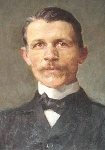Knut Ångström
This article includes a list of references, related reading, or external links, but its sources remain unclear because it lacks inline citations. (March 2012) |
Knut Johan Ångström | |
|---|---|
 | |
| Born | 12 January 1857 |
| Died | 4 March 1910 (aged 53) |
| Nationality | Swedish |
| Scientific career | |
| Fields | Physics |
| Institutions | Uppsala University |
Knut Johan Ångström (12 January 1857 – 4 March 1910) was a Swedish physicist. He was the son of physicist Anders Jonas Ångström and studied in Uppsala from 1877 to 1884, when he received his licentiat-degree, before going for a short time to the University of Strassburg (Strasbourg) to study with August Kundt. Coming back to Uppsala, he completed his doctoral degree and was appointed lecturer in physics at the new university college in Stockholm (now Stockholm University) in 1885. After a few years working there, he returned to Uppsala in 1891 and received the professorship of Physics in 1896.
He focussed his research investigating the radiation of heat from the sun, terrestrial nocturnal emission and its absorption by the Earth's atmosphere, and to that end devised various delicate[clarification needed] methods and instruments, including his electric compensation pyrheliometer, invented in 1893, apparatus for obtaining a photographic representation of the infra-red spectrum (1895) and pyrgeometer[1] (abt. 1905).
He was elected a member of the Royal Swedish Academy of Sciences in 1893.
References
- Ångström K, 1900, "Ueber die Bedeutung des Wasserdampfes und der Kohlensäure bei der Absorption der Erdatmosphäre", Annalen der Physik Bd 3. 1900, p720-732. http://www.realclimate.org/images/Angstrom.pdf
External links
- Olof Beckman, Anders Jonas and Knut Ångström (in Swedish)
